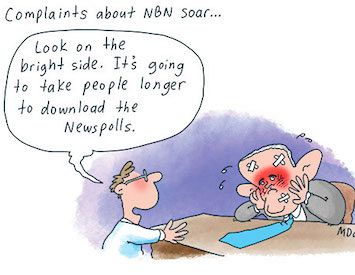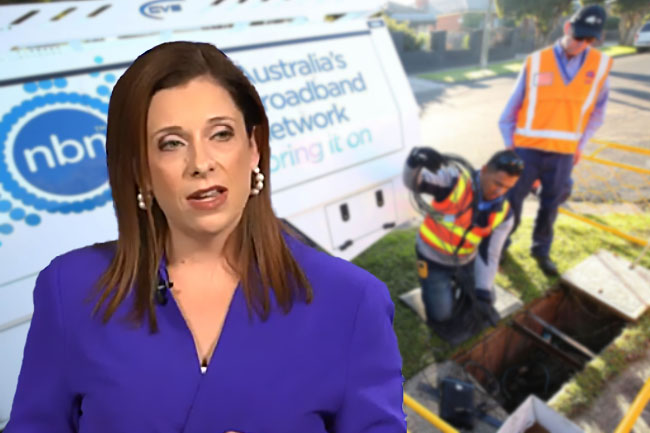After promising to deliver a cheaper, faster NBN and choosing a second-rate alternative to the previous Labor Government's plan, Turnbull now admits it is a "calamitous train wreck" — but still blames Labor. Paul Budde reports.
IT HAS TAKEN four years for the Coalition Government and NBN Co to finally admit what many people have been warning since the beginning of the change from fibre to the home (FTTH) to fibre to the node (FTTN)
Prime Minister Malcolm Turnbull claimed that the "train wreck" was coming along. If that is so, why did he then overrule former Prime Minister Tony Abbott's argument to “kill the NBN” that would have nipped that train wreck in the bud?
Obviously, he didn’t see his change in policy as a train wreck in the making as he indicated he could build the NBN for $25 billion and it would be finished by 2016.
We all know what happened: the price tag is now $50 billion to be finished in 2020/2021 and we are now saddled with a second-rate network.
During my (unpaid) strategic involvement in the initial FTTH NBN, I made it very clear to then Minister for Broadband Stephen Conroy there were several serious flaws in that plan.
These included, the:
- unrealistic high return on investment of six to seven per cent;
- way the NBN would be rolled out (not taking the most urgent areas into account); and
- plan to replace HFC, which, in my opinion, could be done much later as the next phase of the NBN — there certainly was no urgency for that (the same applied to ADSL2+ connections).
Nevertheless, the main blame should go to the current Government, which changed horses halfway and then chose a second-rate solution. This, among other things, resulted in a ban on competitors being allowed to roll out superior FTTH broadband services. Who would have thought such a policy would come from a pro-business Liberal Government? To prop up the NBN, they are even imposing a broadband tax on mobile operators, further damaging telecommunications competition.
It is that second-rate solution (FTTN) that is causing the main problem. There are no complaints from the one million households who were lucky enough to be part of the original FTTH roll out.
In other parts of the blame game, the original NBN plan was compared with the successful rollout of FTTH in New Zealand.
One of the reasons why we have the current model of the NBN is because of the position taken by the then CEO of Telstra Sol Trujillo, who wanted to maintain Telstra’s monopoly at all costs. He didn’t want to roll out a nationwide high-speed broadband and, instead, wanted a regulatory holiday to roll out the FTTN broadband network to approximately 50 per cent of the population for which he wanted a regulatory guaranteed subscription charge of $95 per month (later reduced to $85). He then sued the Howard Government when they wanted to change the Telstra monopoly.
If we want to go even further back in the Howard years, it was under his watch that Telstra was privatised, without any conditions attached to regional broadband, or to an upgrade of the network from copper to fibre. Sol Trujillo happily used the monopoly handed to Telstra by the then government.
The situation in New Zealand at that time – as it was in most of the other leading broadband countries such as the ones in Scandinavia and Eastern Europe, Singapore, Hong Kong, Korea, Japan, and so on – was far more co-operative. So these countries didn’t have the trouble that Australia was facing. Yes, with hindsight and with the current Telstra management in place a better outcome would have been possible — however, in the Trujillo period, this was simply not an option.
To a certain extent, we still suffer from this as NBN Co must pay around $1,000 per house to Telstra for the use of their ducting and cabling.
Also, if that train wreck was already in place in 2013, when the Coalition Government changed the plan, politicians might not have seen it coming, but one would have expected some pushback on this train wreck from the engineering experts (being NBN Co) to the contrary. But they have happily let the train wreck move forward and keep on talking it up. At the same time, rather than promoting high-speed broadband, the CEO (Bill Morrow) kept on talking that down — now even indicating that 10Mbs is fine for him.
Now it is suddenly a blame game, but only a few days ago, the Communications Minister Mitch Fifield was still taking-up the current NBN, telling TV audiences that the NBN soon would be the "envy of the world".
Then there is this list of premises that costs tens of thousands of dollars per premises to connect to the NBN. We can very easily make similar calculations for roads, electricity, gas and water connections. What about four homes on a two kilometre tarred road, or electricity connection to rural communities and farmsteads?
So yes, there have been wrong decisions all along, but my advice to the PM in 2013 was to keep the original NBN in place and make the changes such as the ones I mentioned above — perhaps taking longer to complete, spreading the costs over a longer period. Obviously, you would make adjustments as the rollout would continue. The City of San Francisco just proposed an FTTH network that will cost US$2,000 (AUS $2,562) per home to roll out — the costs of FTTH rollouts is coming down day by day, so it doesn’t have to be a train wreck.
On the positive side, the current admissions are potentially making it possible to look at solutions. By writing off 50 per cent of the rollout costs, the Turnbull Government could, with one stroke of the pen, make it instantly possible to deliver more affordable true high-speed broadband. This would then also provide a better platform for the next step of the NBN, be it privatisation of the company, or finishing the current roll out by NBN Co with FTTH as the end goal — something the Prime Minister has also mentioned in the past as being the preferred end goal.
In the meantime, stop the roll out of the FTTN and replace it with FTTC (fibre to the curb). More money spent on FTTN will only make the NBN less valuable and continue the waste of taxpayers’ money. If the price for this is a delay of another one or two years, so be it — better to do it right in the first place.
Paul Budde is managing director of Paul Budde Communication Pty Ltd, an independent telecommunications research and consultancy organisation. You can follow Paul on Twitter @paulbudde.
This article was originally published on BuddeCom and is republished with permission.
Monthly Donation
Single Donation
Stay in touch. Subscribe to IA for just $5.











